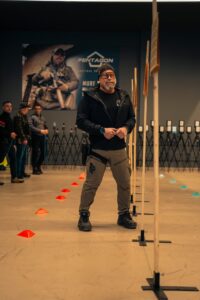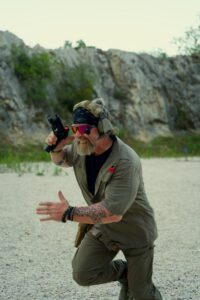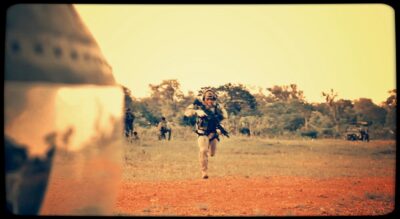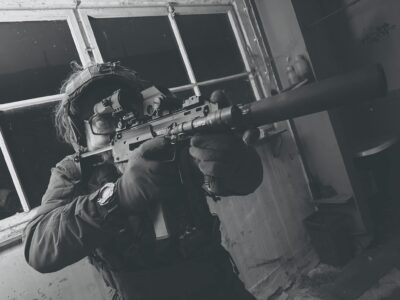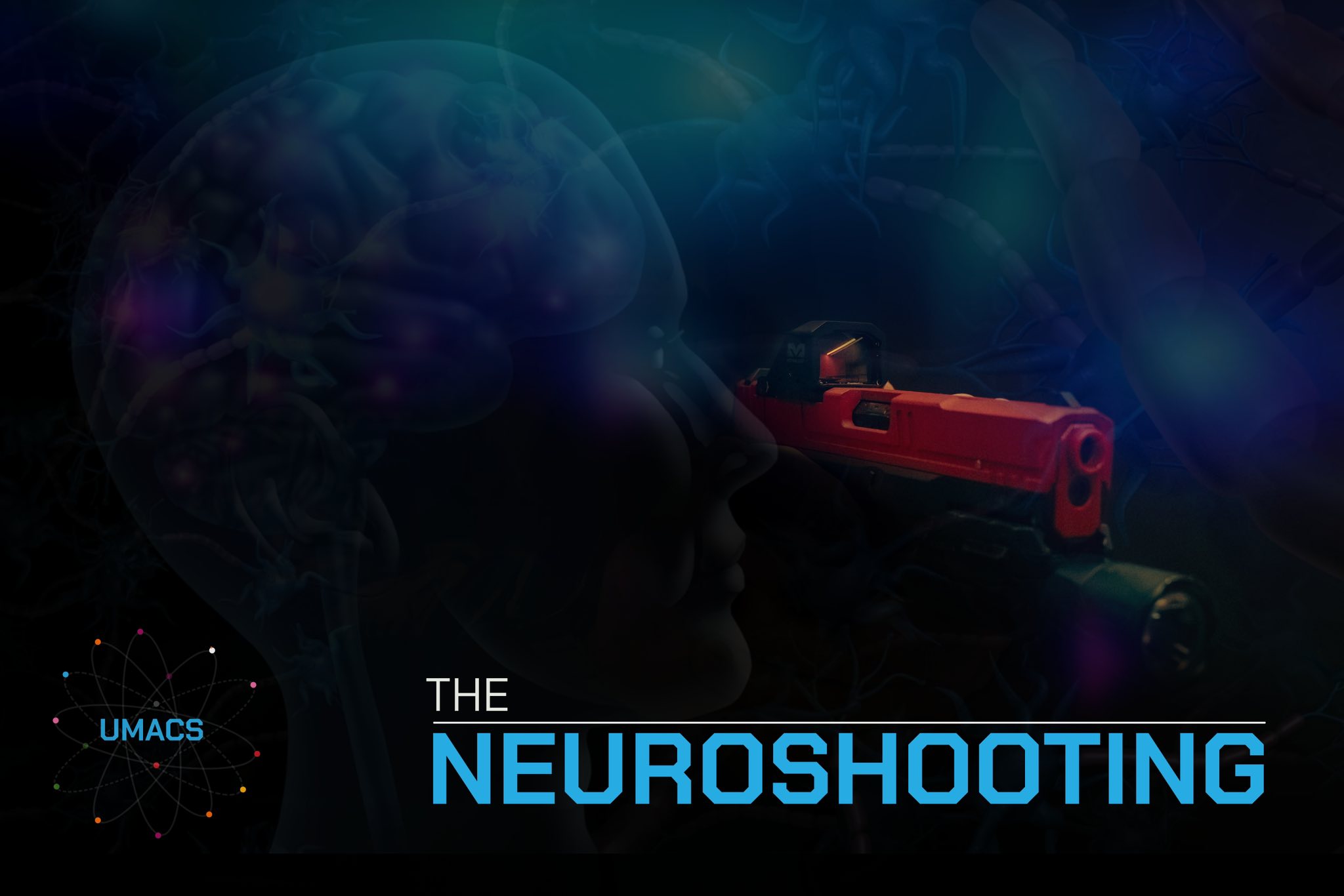The Noise, the Method, and the Mind: Anatomy of a Drill and the Void Surrounding It
I recently shared a short 30-second video, just one of many technical snippets. It showcased a drill performed in DRY-SIM, using a short platform and a set of simple, low-cost tools accessible to anyone. A zero-risk drill, designed to be applicable, sustainable, realistic. Nothing exotic, nothing inaccessible. Just structure, consistency, method.
That drill is part of a much broader training program: NeuroShooting, the pioneering model I created to push professional fire@@@s training beyond the limits of the mechanical approach, toward what science now allows us to achieve. A methodology that integrates neuroscience, biomechanics, neuroplasticity, and the real-world application of fire@@@s in non-predictive contexts. Because, contrary to what many believe, it’s not your finger that makes you pull the trigger — it’s your brain. And if you only train your finger but not your brain, all you’re doing is refining an empty reflex, not building true adaptive capacity.
The Noise of Superficiality
The video went viral. It’s only the second time ever that a DRY-SIM post has reached “viral” numbers, quite a small record, considering how the market typically ignores or rejects anything that isn’t pure entertainment at a shooting range.
But going viral has its price.
In return, I didn’t receive questions or technical feedback; I got comments. Dozens, hundreds. Most of them positive, some negative, some offensive, many just senseless and utterly hollow.
Personal judgments, empty, brimming with a confidence so loud yet so unfounded. Not one offered data, studies, scientific references, or evidence refuting what I had shared. On the contrary, they demanded even more proof, as if the explanation already provided, simplified for a wide audience, were not enough. As if it were normal to question something they hadn’t even understood.
Distorting “Realism”
A striking feature of these comments is the utter confusion between training and real scenario.
Many label this drill as “not realistic,” as if it were meant to faithfully replicate a real-world scenario. It’s like telling a boxer that hitting a heavy bag isn’t realistic because it doesn’t hit back, or telling a Formula 1 Pilot that psycho-physical conditioning outside the car is useless because “there are no corners.”
Yet, at the same time, they call “realistic” those team-based vehicle courses sold to civilians, despite the fact that actual real life statistics are practically nonexistent, and the scenarios they offer cannot be applied in the real world.
Or they praise the supposed “realism” of flashy, stagey CQB courses offered to people who, more often than not, barely know how to hold a g@n, yet are still thrown into extremely complex operational dynamics, challenging even for a professional.
It’s shocking and paradoxical, yet perfectly consistent with this industry dominant mindset, where tactical aesthetics wins out over scientific substance every single day, both at the range and on social media. In this light, everything ends up making sense, even if it really shouldn’t.
Judging Without Knowing and Without Trying
And here’s the real question: how can anyone judge a technical drill, complete with biomechanical and neuroscientific underpinnings, after watching just 30 seconds of a social media video?
How can you challenge something you’ve never tried, never tested, never measured in terms of results?
How can you have the arrogance to call yourself an “expert” with neither the competence nor the curiosity?
I explained that drill. I broke it down. I shared it for free, as I’ve done for years with most of my technical content. I never claimed it was the only way, nor the best way. I said it was effective because I’ve seen it work. I let the results speak for themselves. But none of that matters, not when certain nerves are touched.
The real issue isn’t the drill: it’s that it doesn’t conform to the masses. It doesn’t follow the dominant empirical approach, with its routine of automatisms, handed-down myths, and standard range practices.
It doesn’t feed into the profitable trends of the civilian market. And so, for many, it becomes a threat a foreign body to be expelled, not understood.
Science Versus Empirical Tradition
The fi@@@rms industry is still trapped in an archaic, static, closed structure.
A world that glorifies mechanical movements while ignoring what science clearly shows: the real-world environment is non-predictive, and effective responses cannot be predictive either.
Training only on the mechanical side means you’re practicing predictive responses in a controlled setting. But out there, in the real world, there is no predictability. There is adaptation.
And adaptation doesn’t come from repetitive gestures. It comes from the brain, from stressors, from disruption, from interference.
Training without involving the brain is like studying dance for years… and then expecting to dance on a floor that’s crumbling beneath your feet.
Science: Essential yet Uncomfortable
In truth, science does not lend itself to tactical tales or “barstool war stories.” It doesn’t sell easily because it requires study, research, experimentation, continuous updates, and solid expertise from instructors. It’s a serious, structured, ethical approach that demands sacrifice, commitment, sweat, and years of training without shortcuts.
Tactical aesthetics, on the other hand, requires only a “Pro” costume for the weekend, a few flashy but pointless accessories, a credit card, and an internet connection. And so the “tactical average shooter” is born, perfectly in tune with the trends of the civilian market.
Conclusion: The Courage to Go Beyond
We’re no longer in the ’60s. We now have data, tools, and neuroscientific discoveries capable of demolishing many of the dogmas this industry has been resting on for decades. But it takes courage to leave the shooting range comfort zone and question the “we’ve always done it this way” mantra.
I will keep sharing, explaining, experimenting, studying. Because knowledge is a public good, and if it doesn’t create progress, what’s it for?
And to those who would rather shout than learn, judge rather than try, or argue rather than understand, I’ll say just one thing:
The problem isn’t what you saw.
The problem is that you didn’t understand what you saw, and you didn’t see what you needed to understand.
Stay Safe out there folks!
